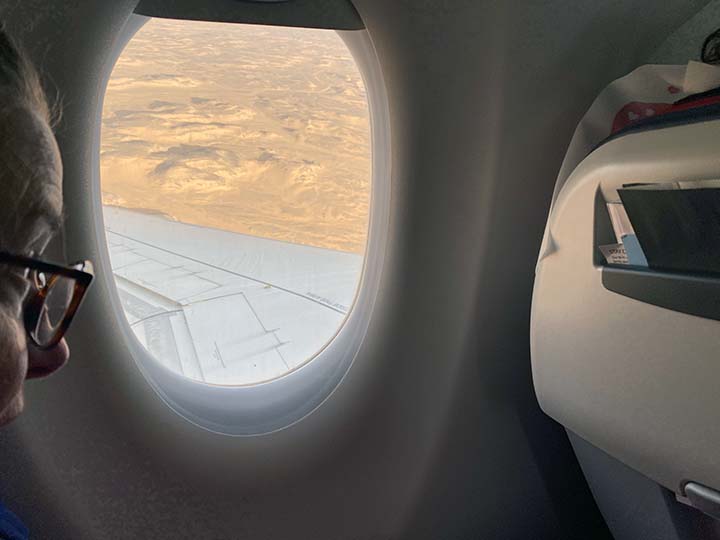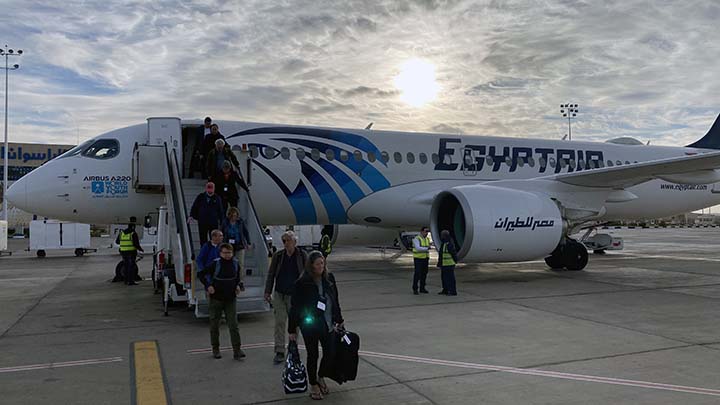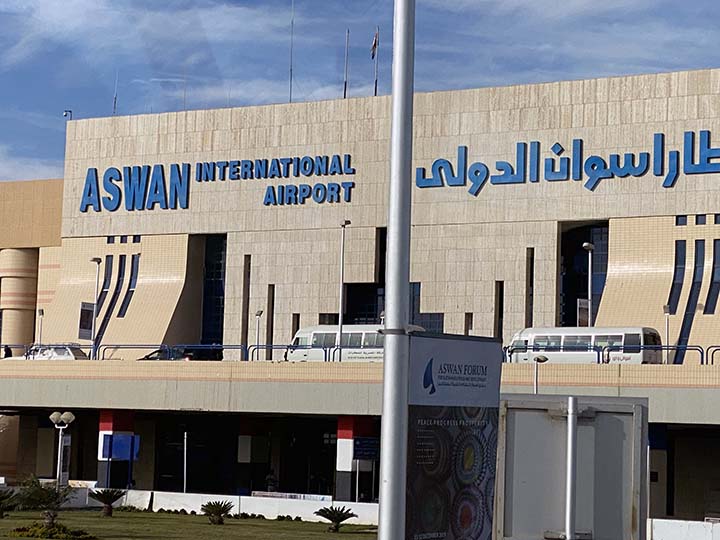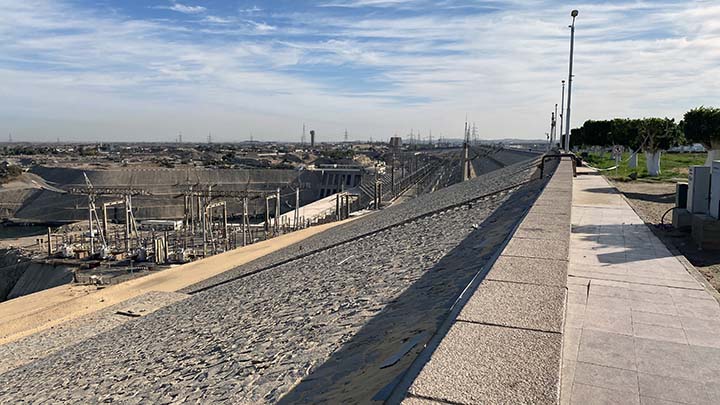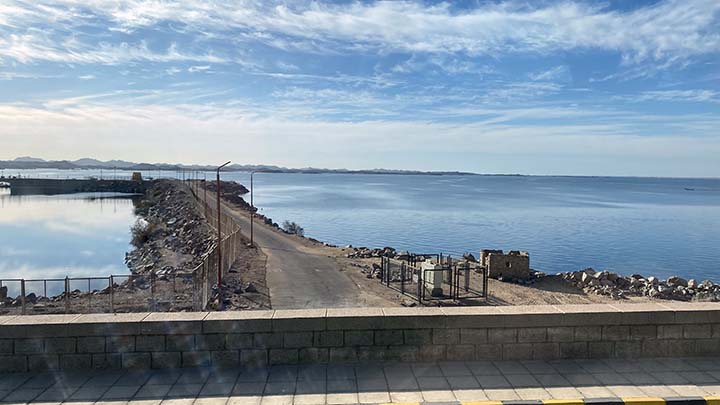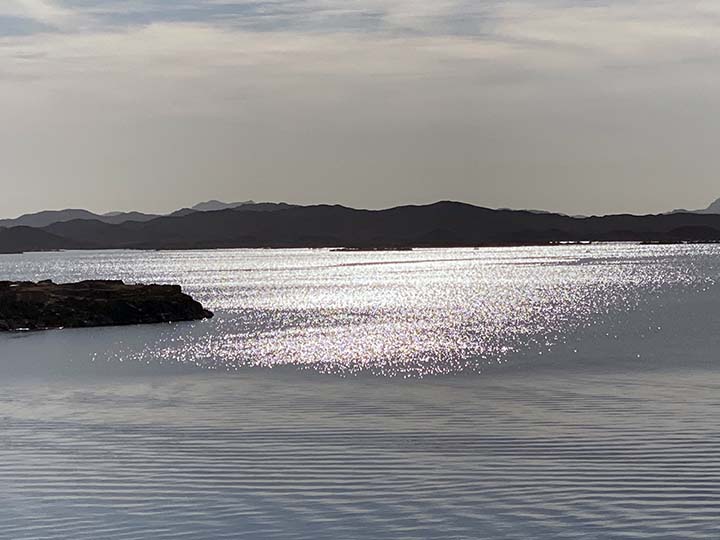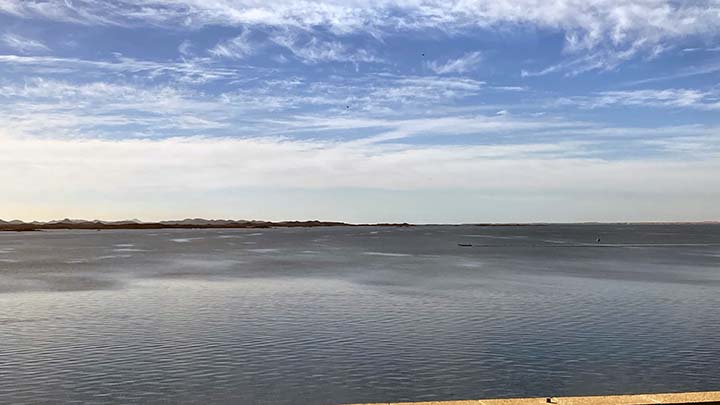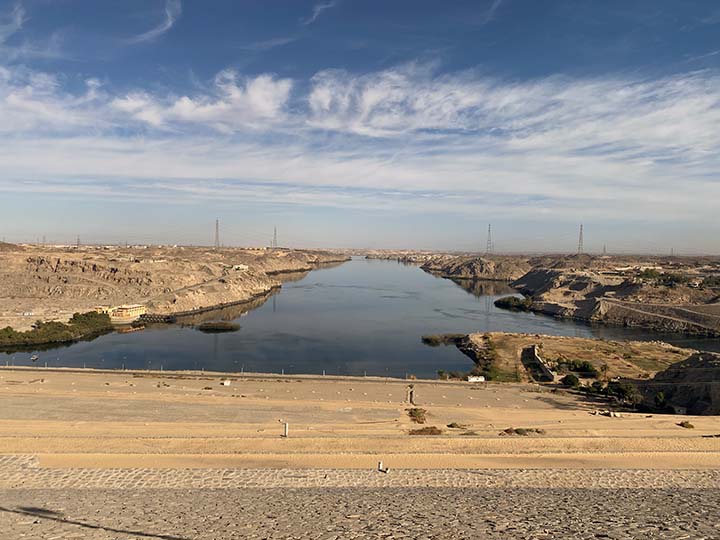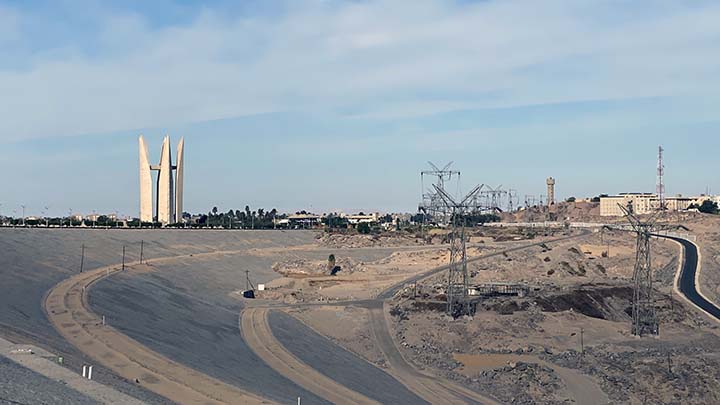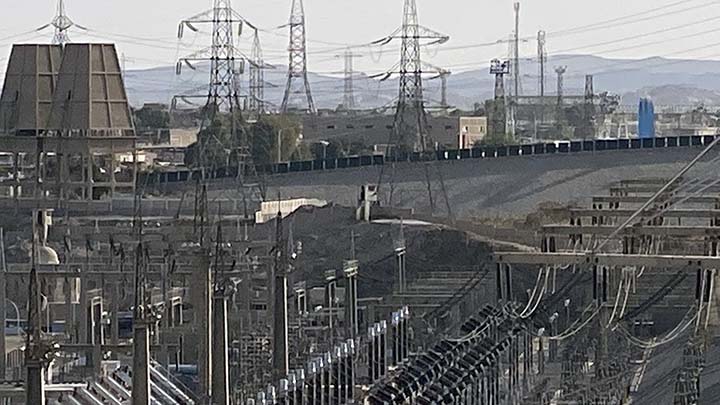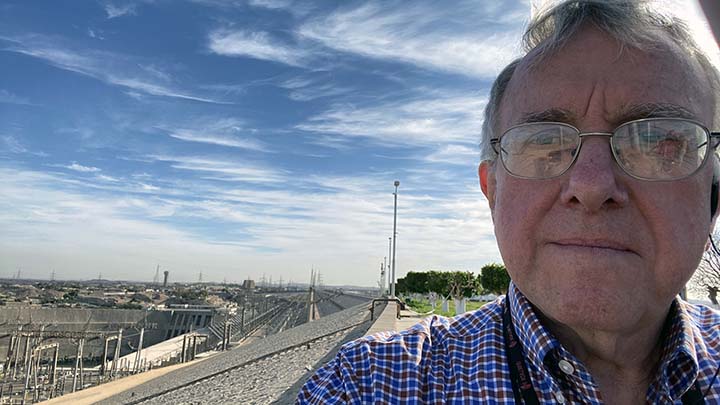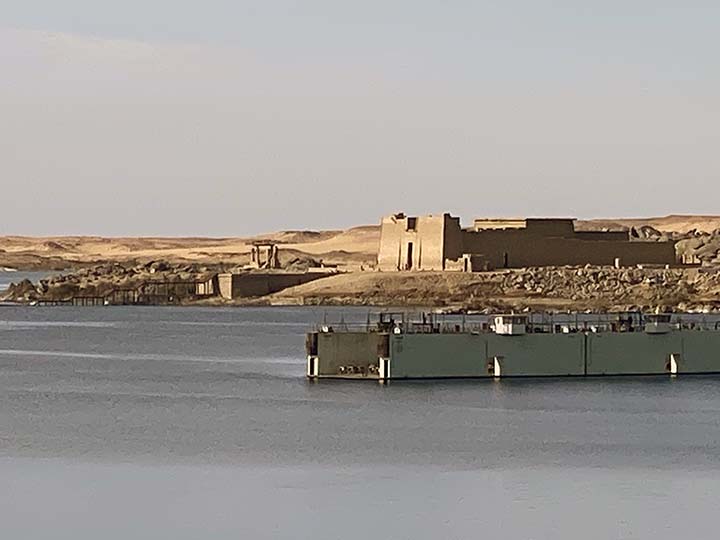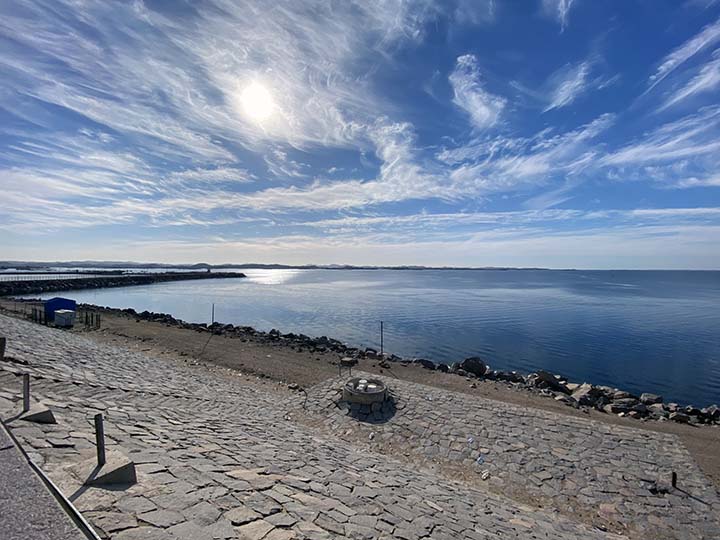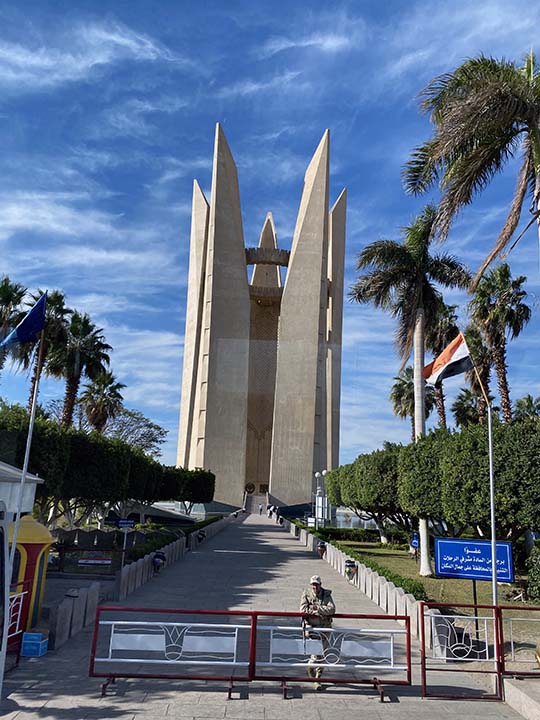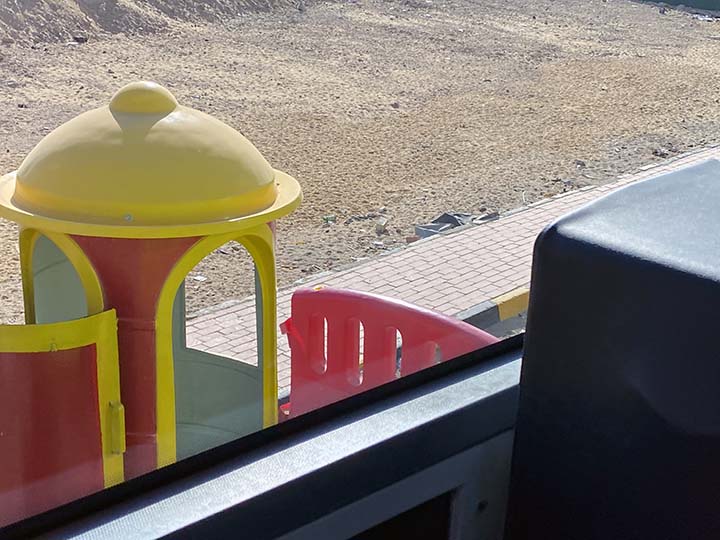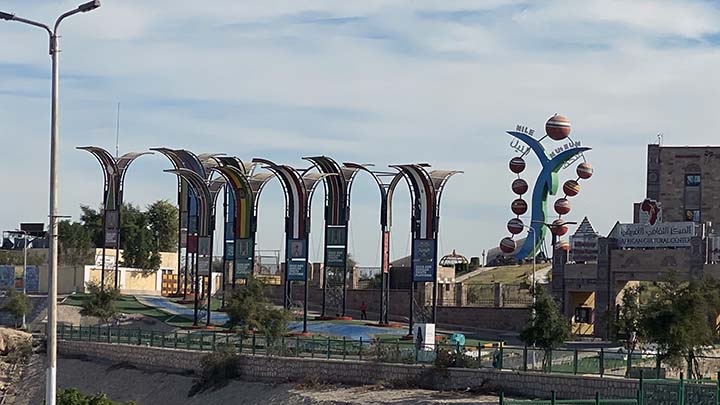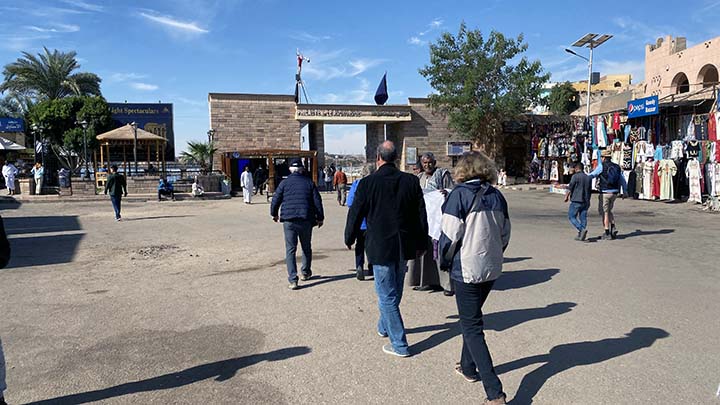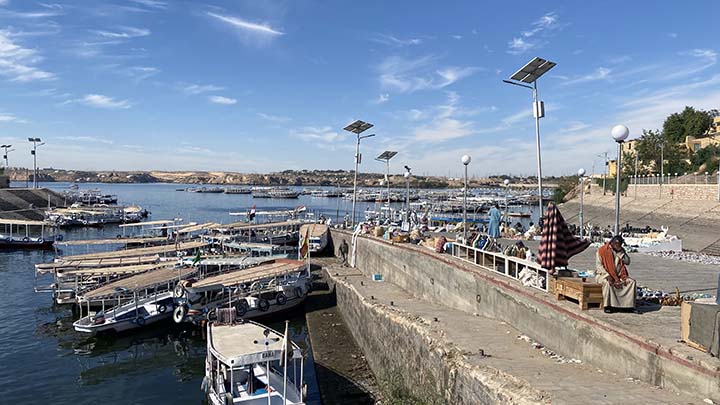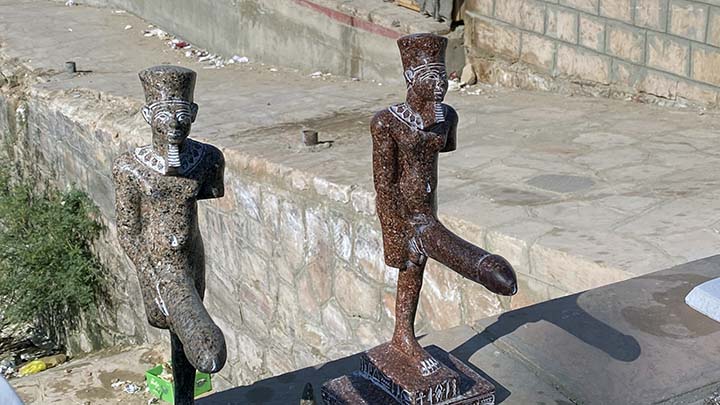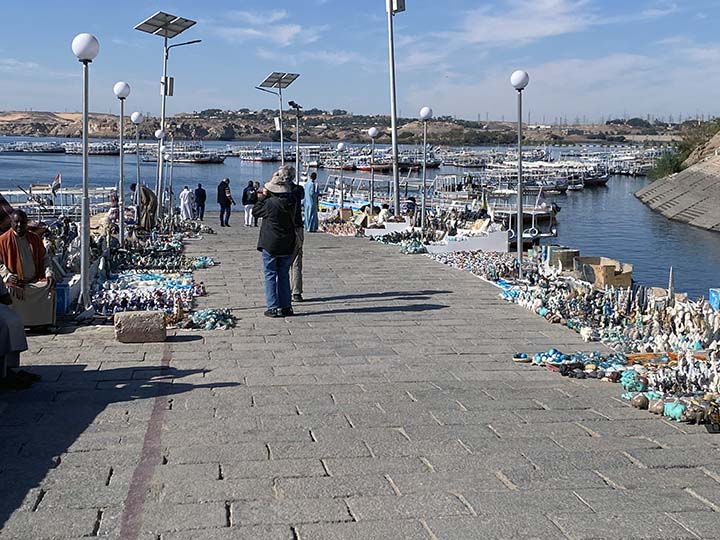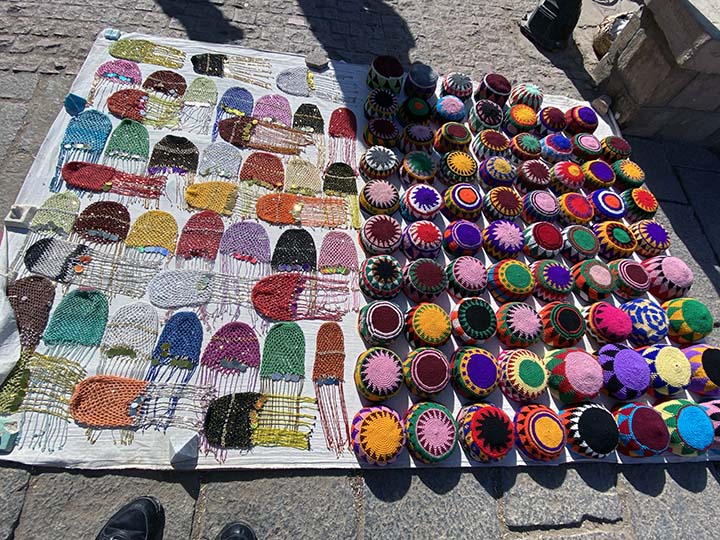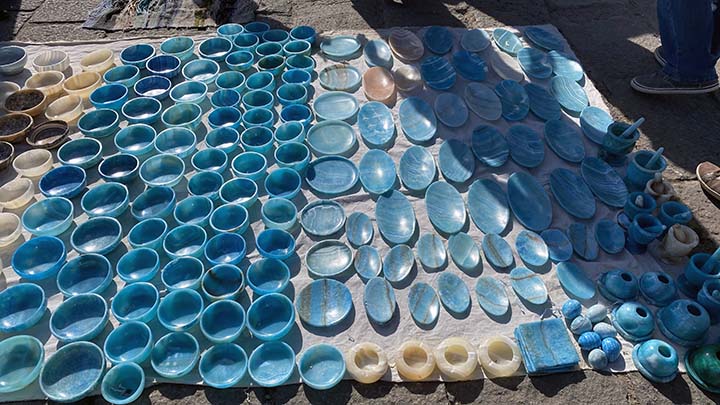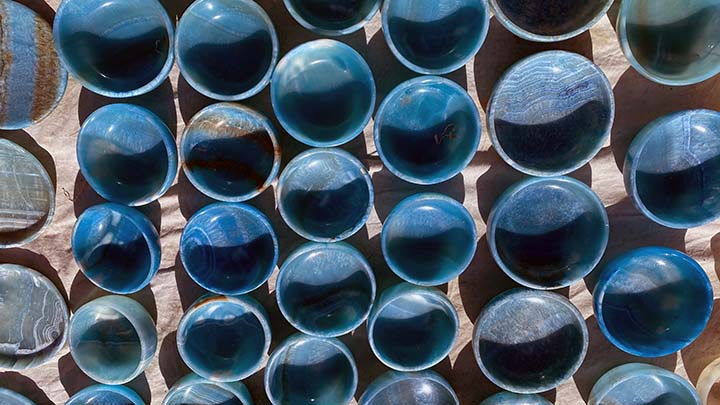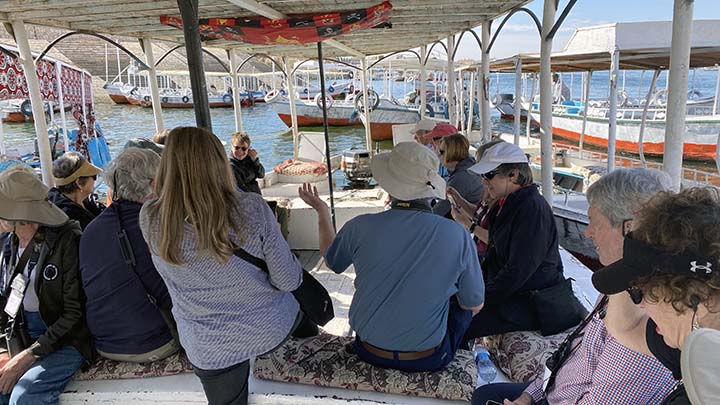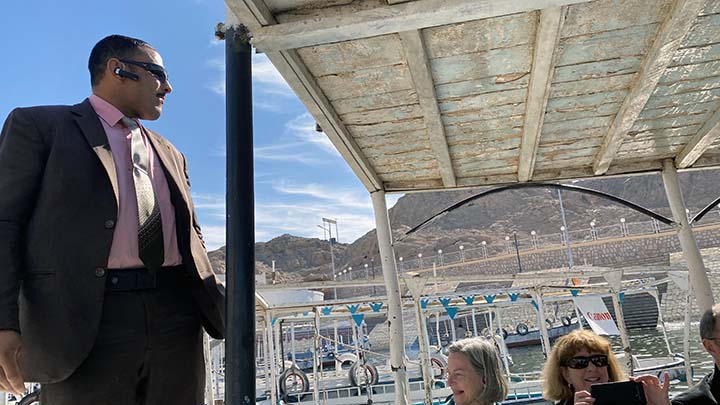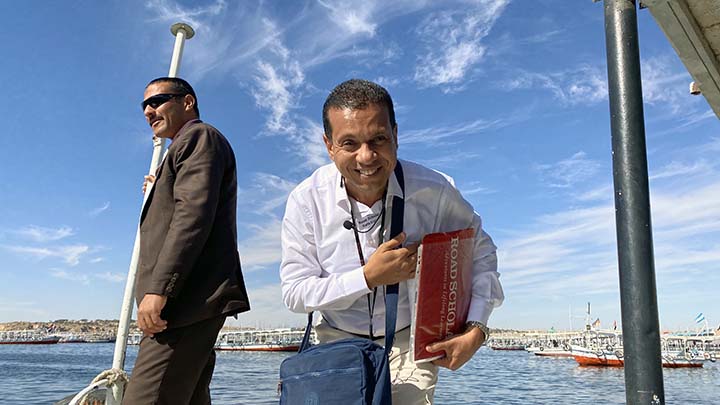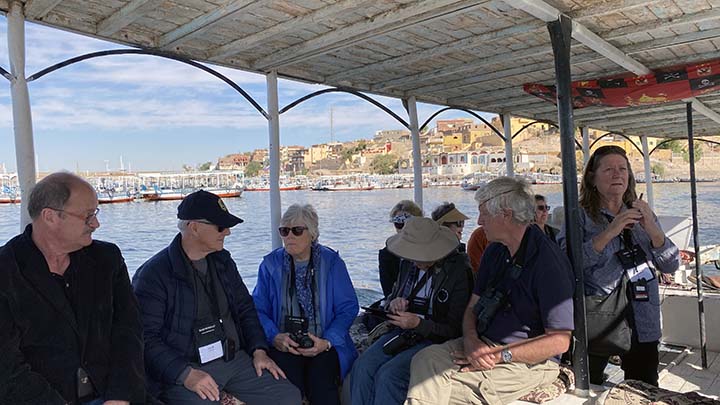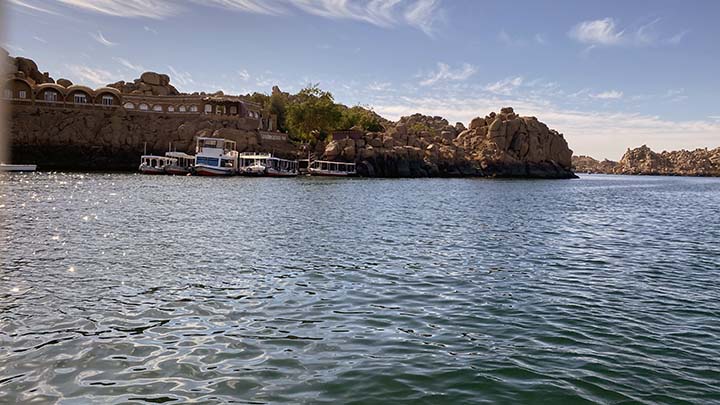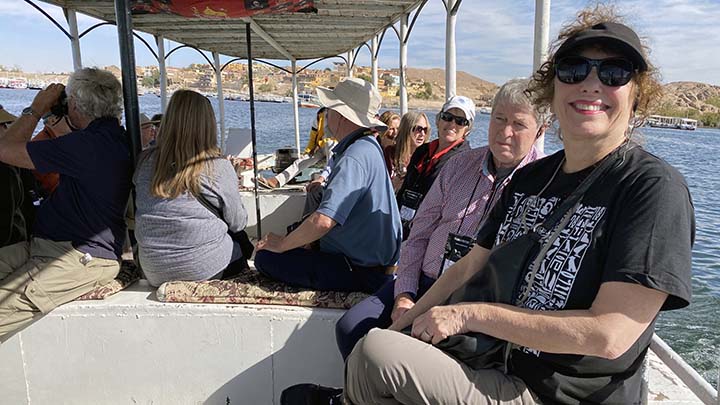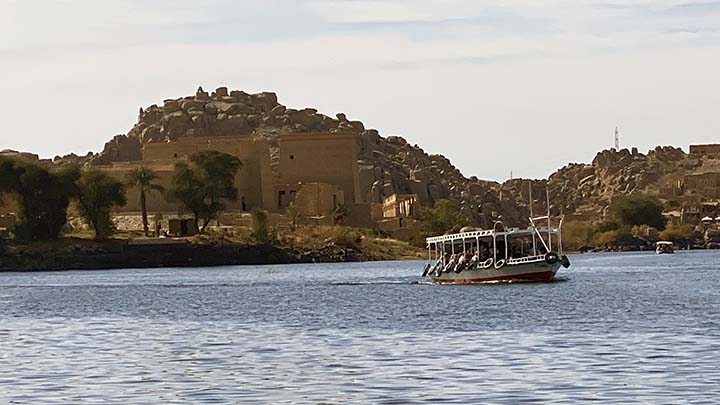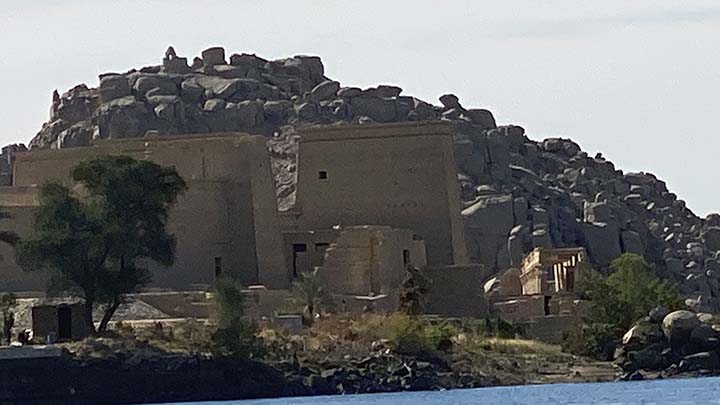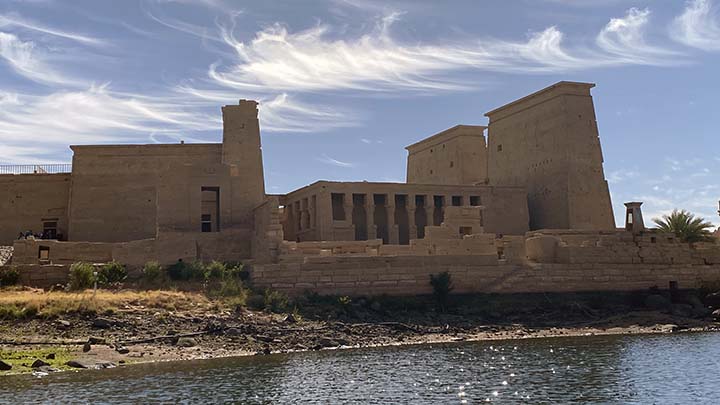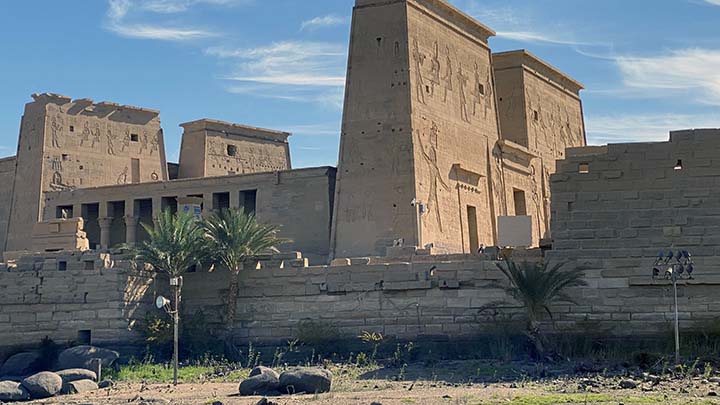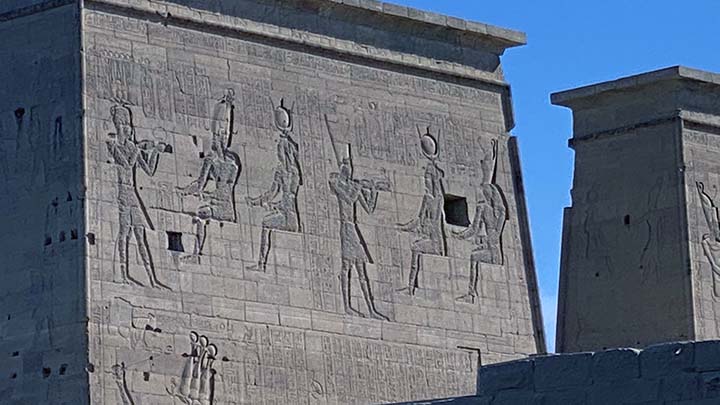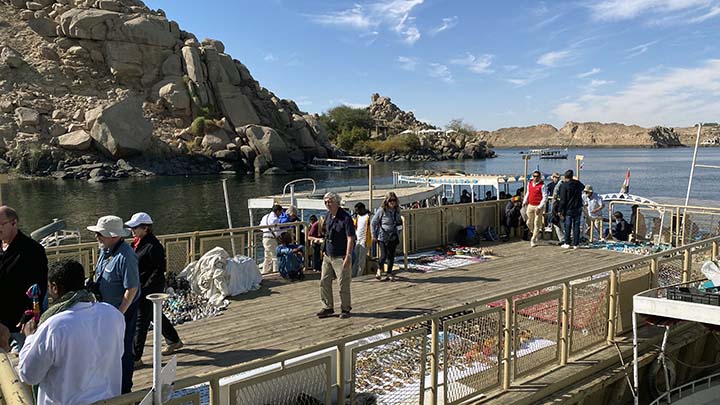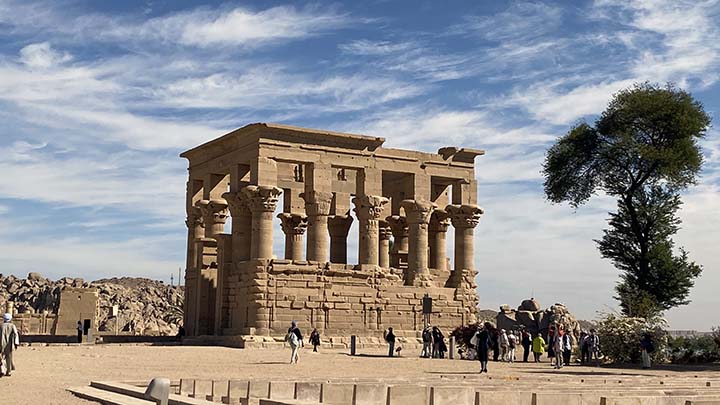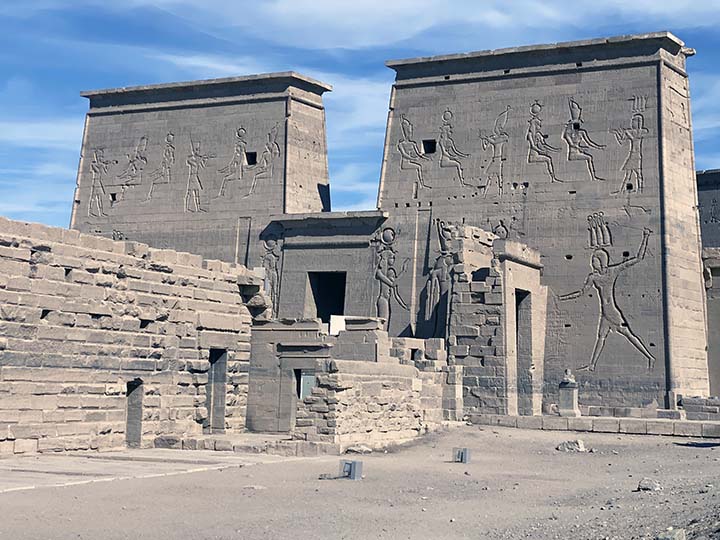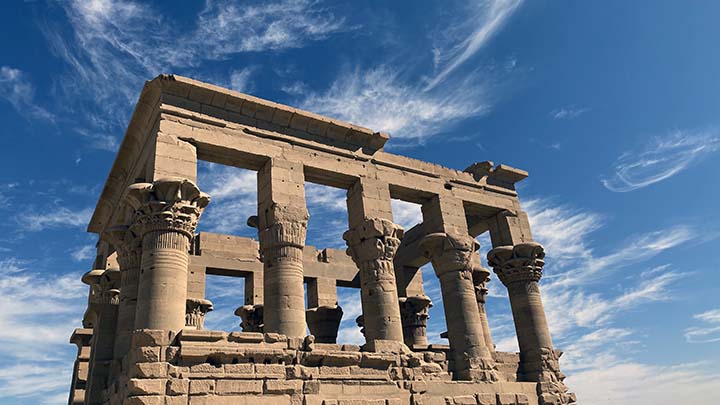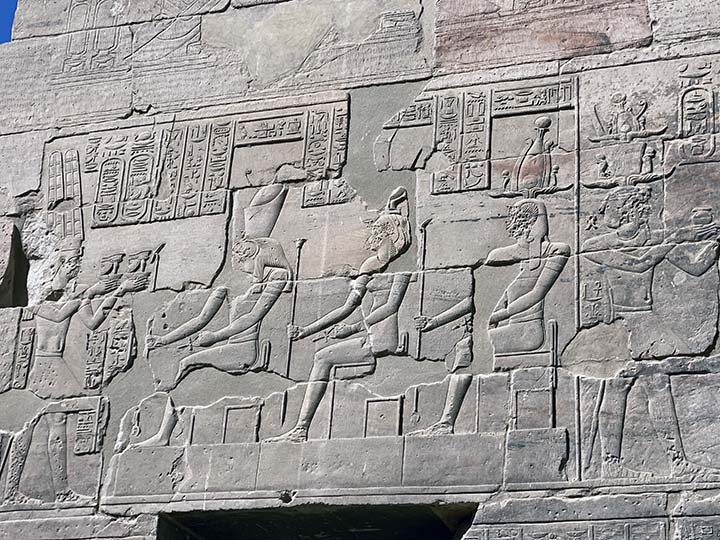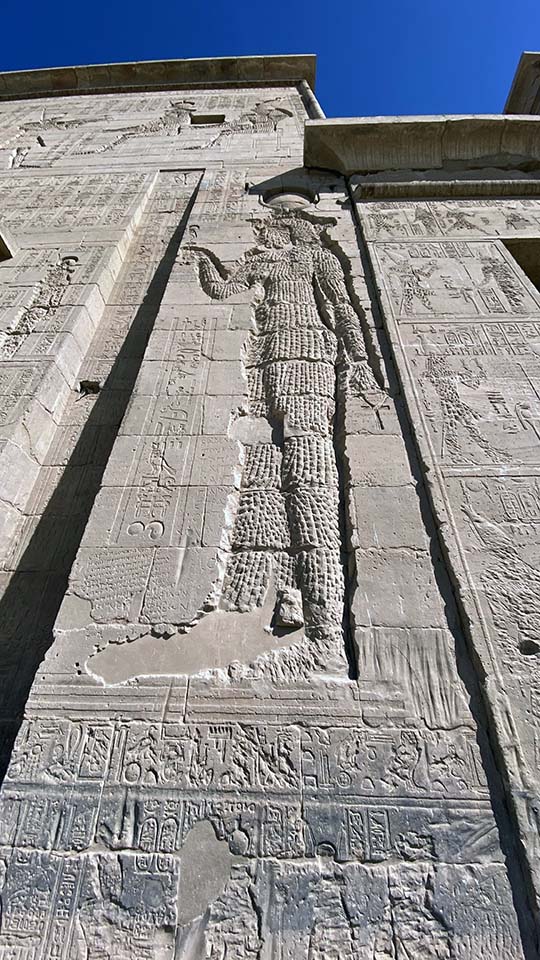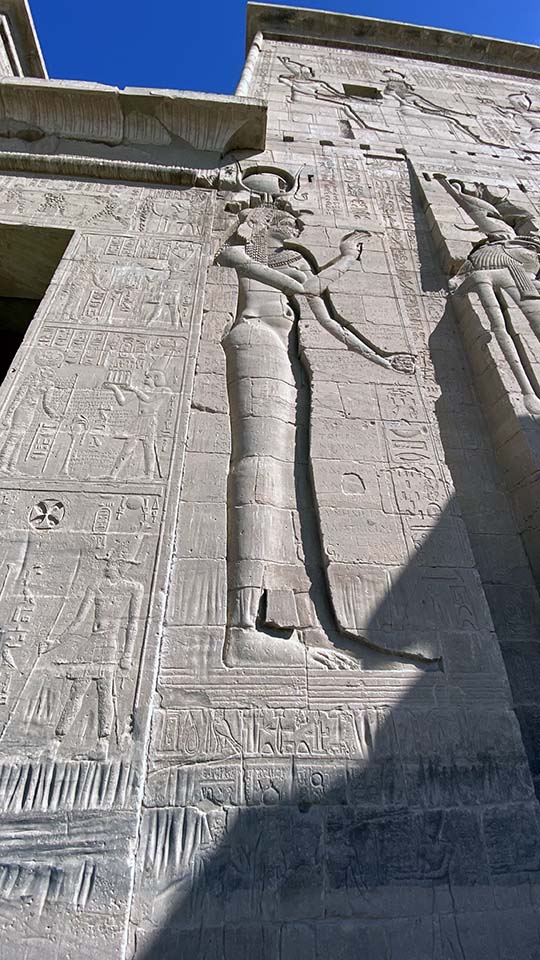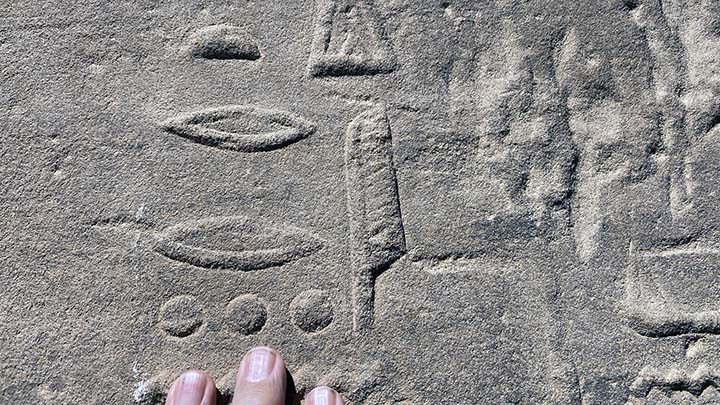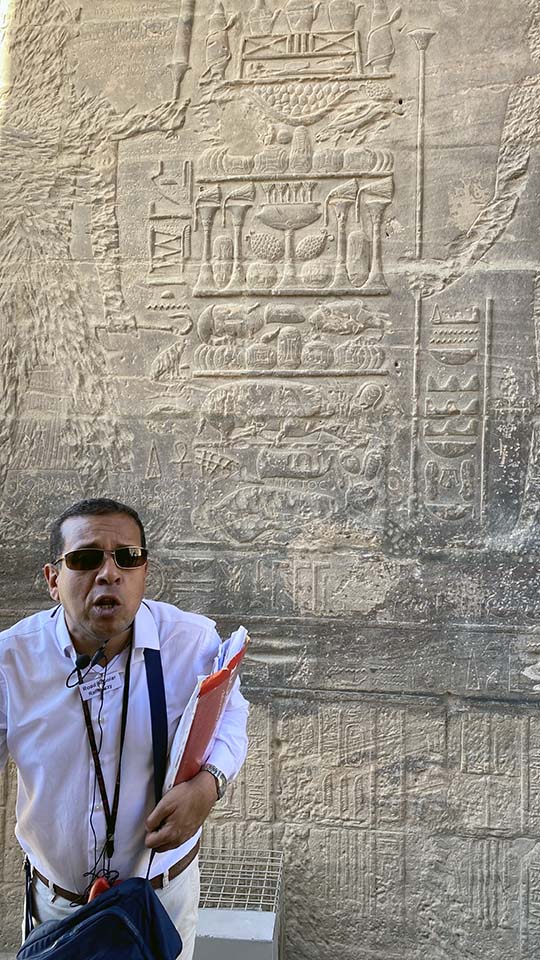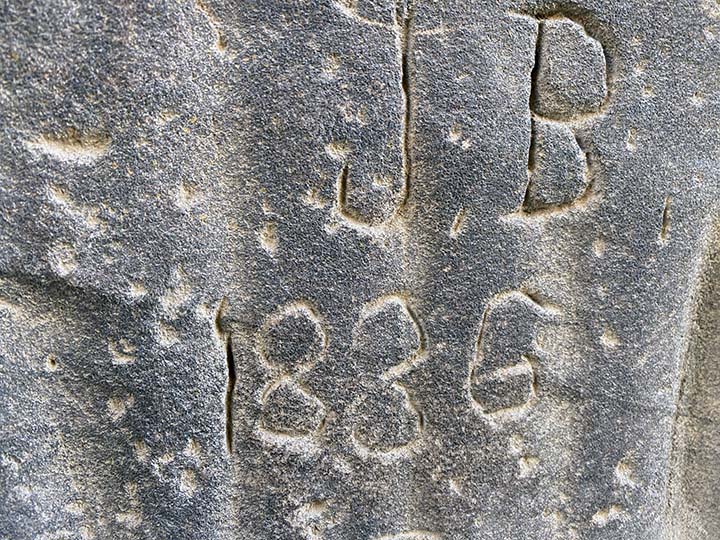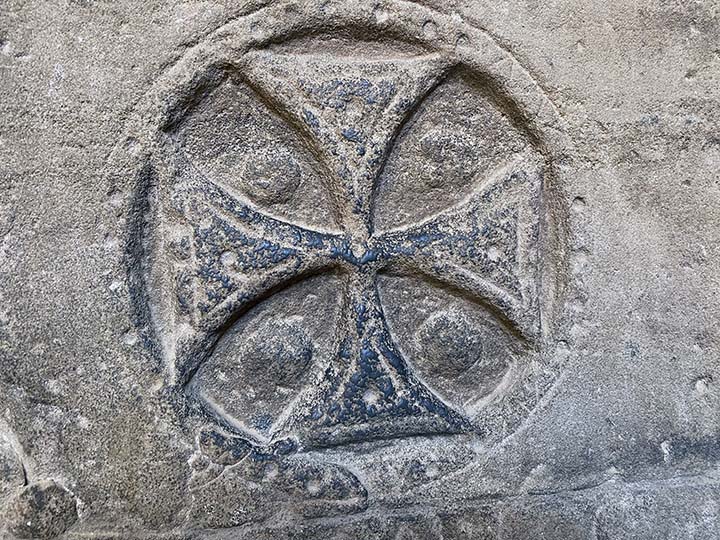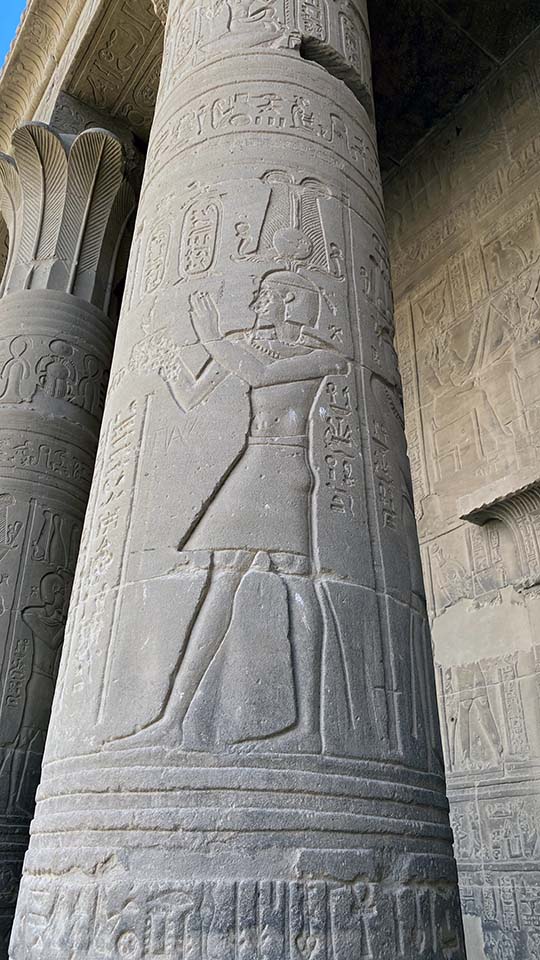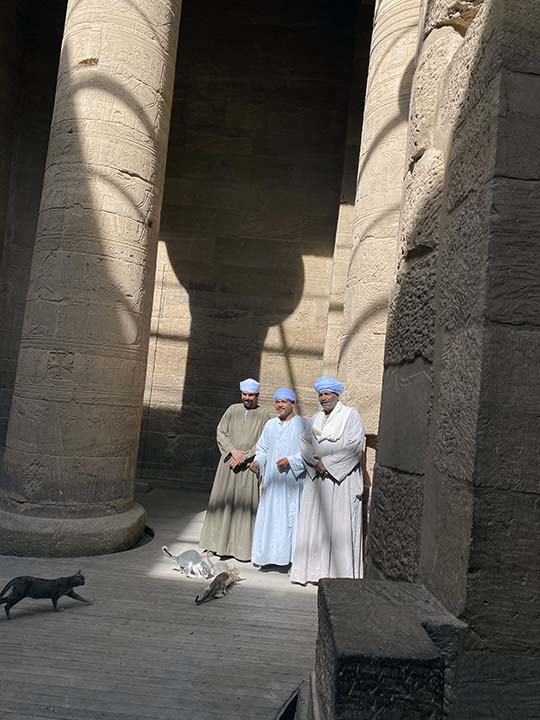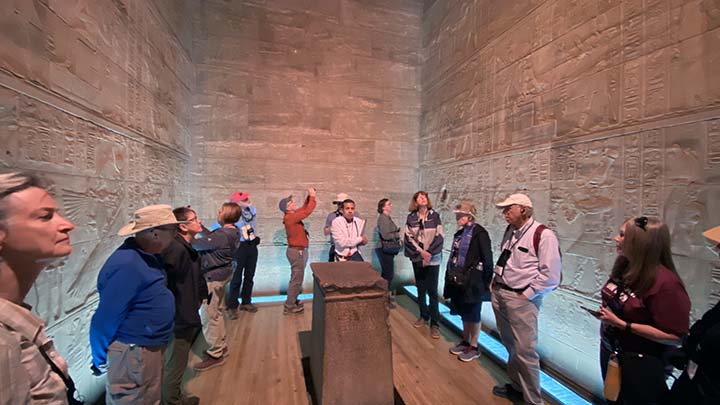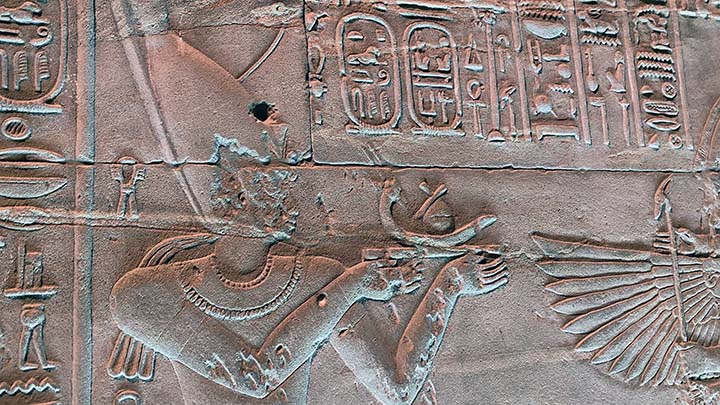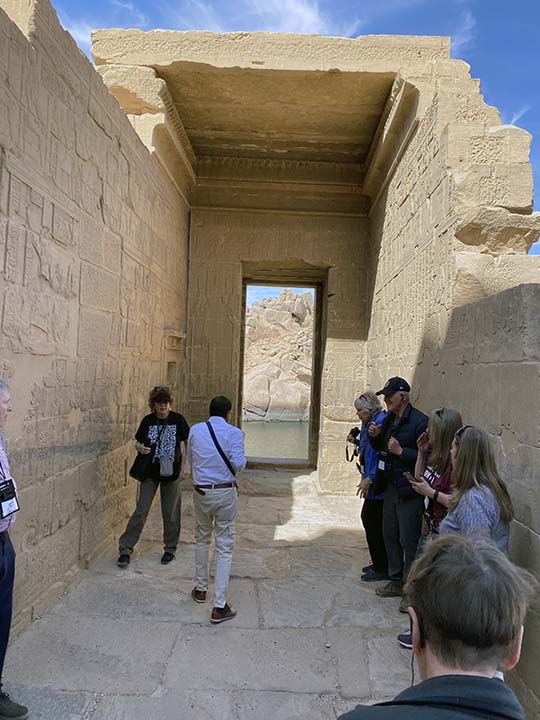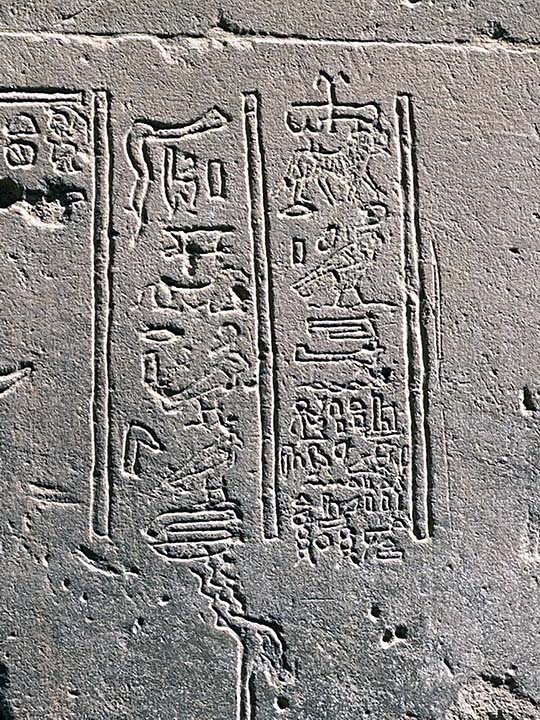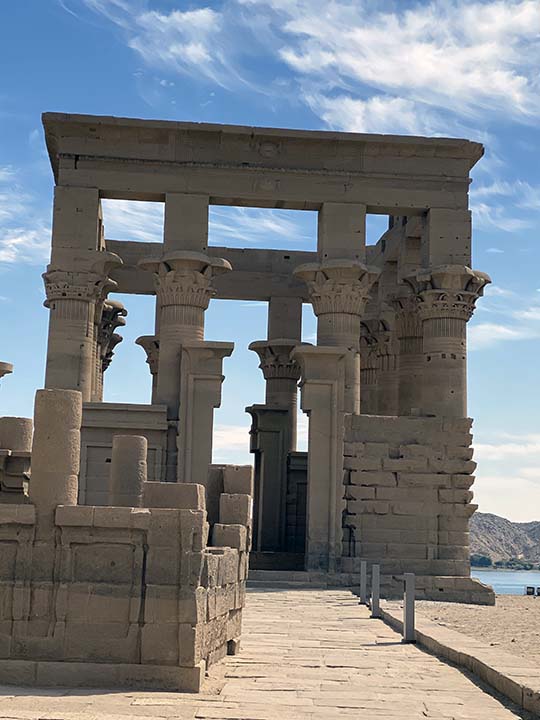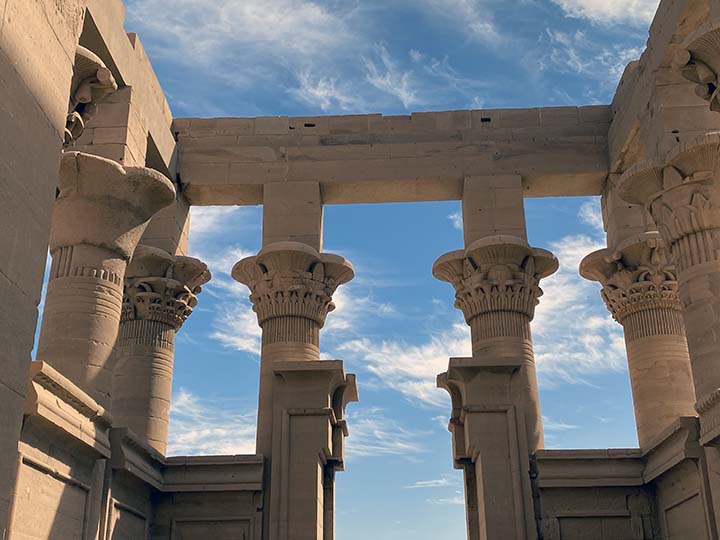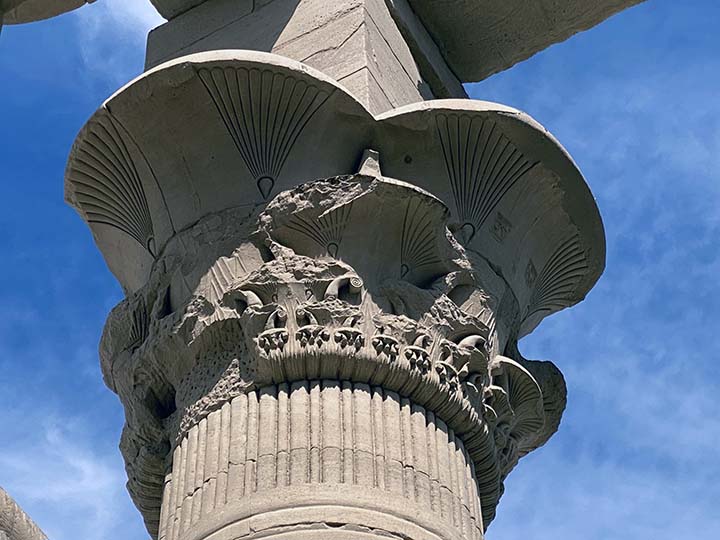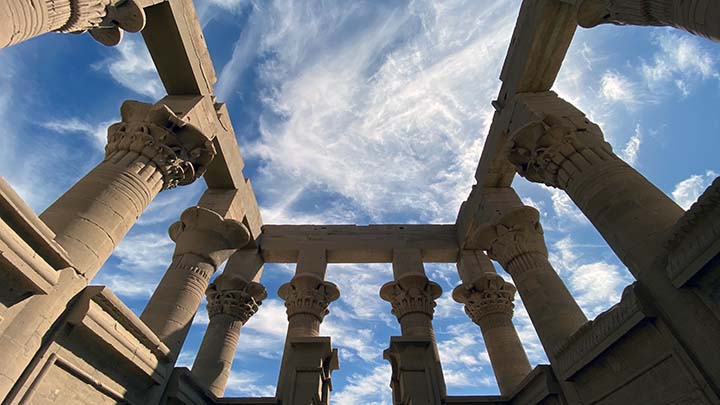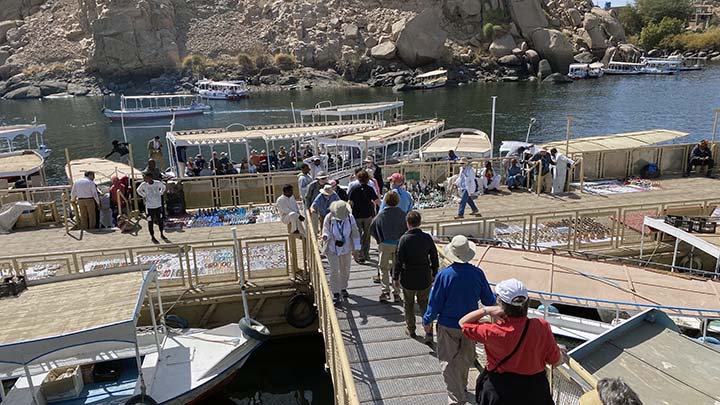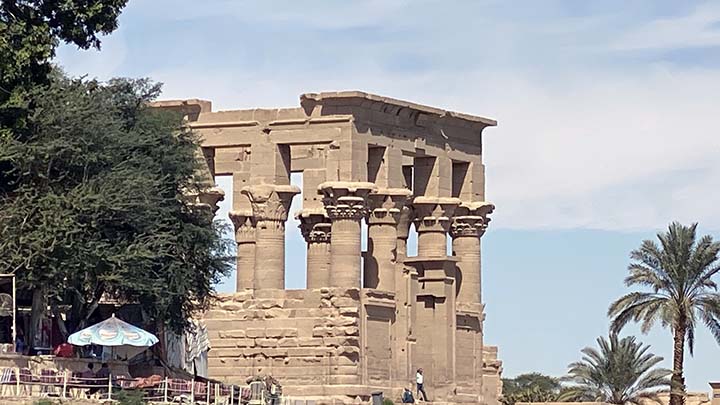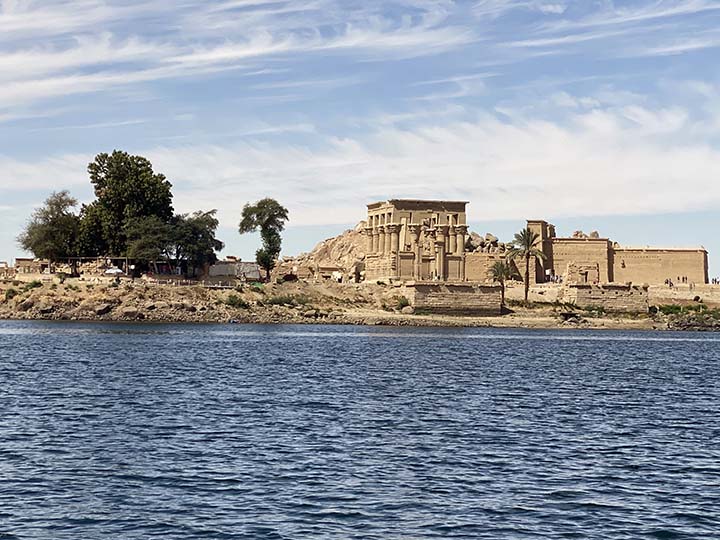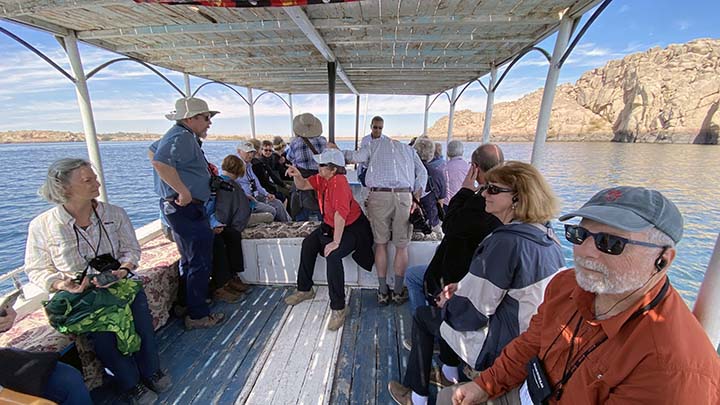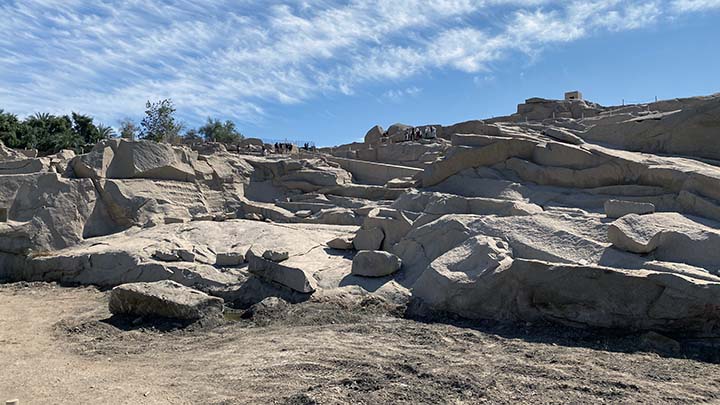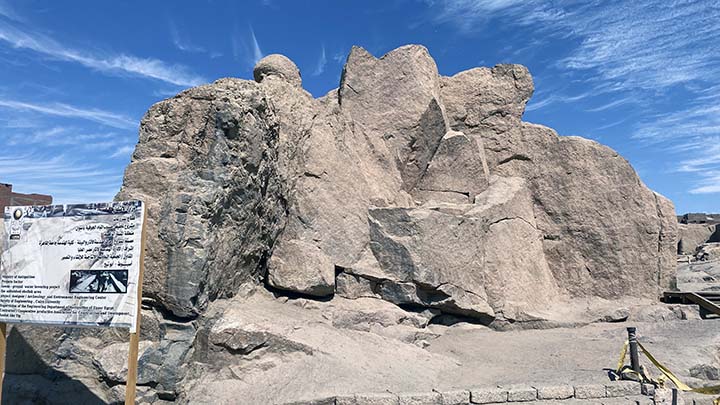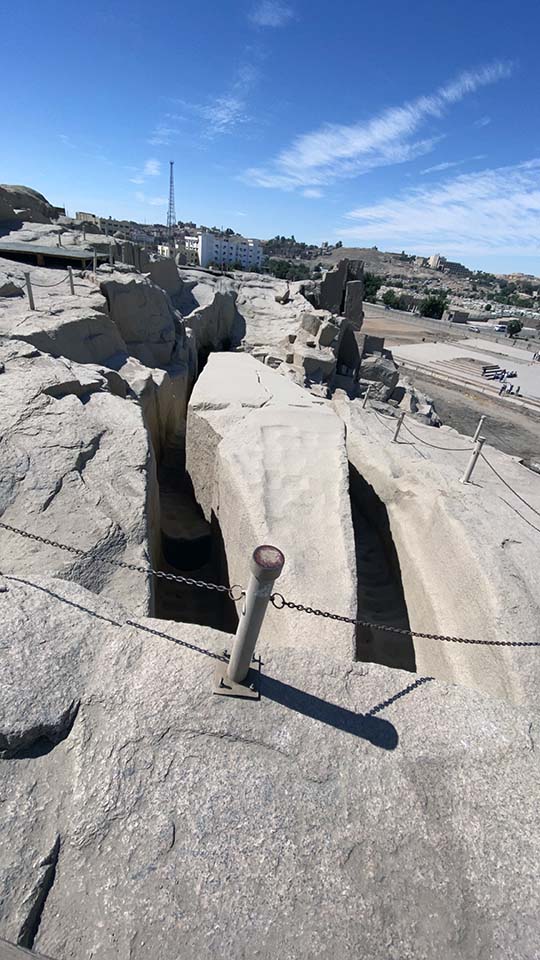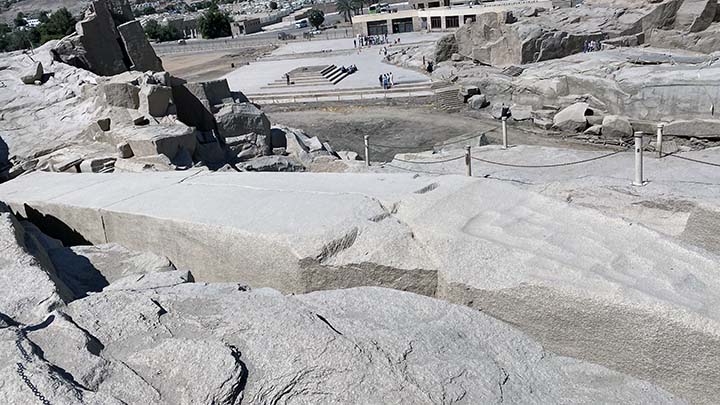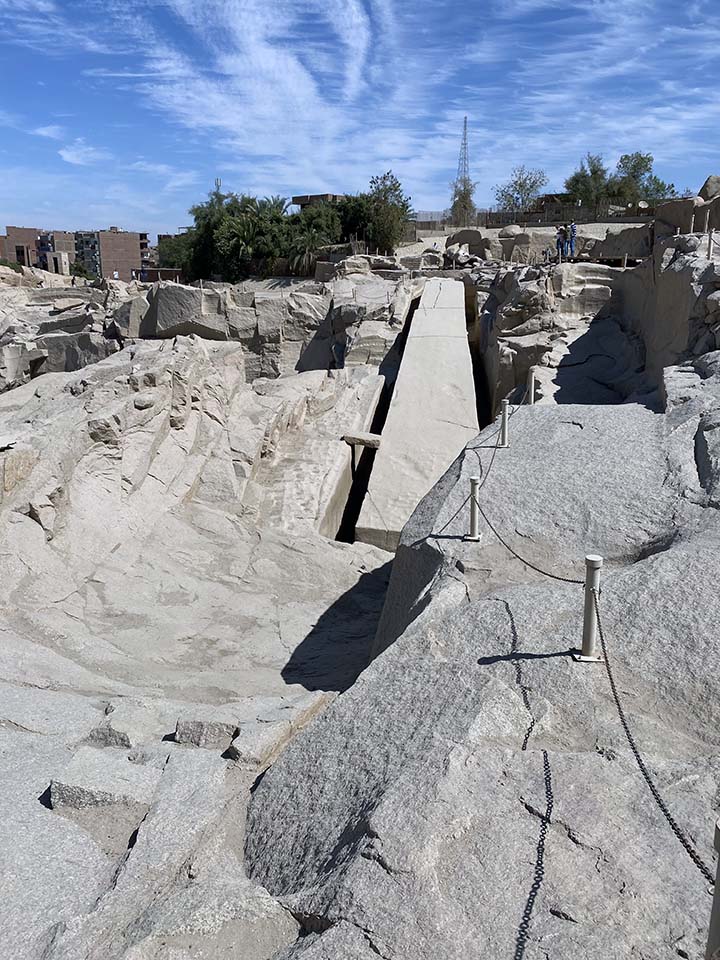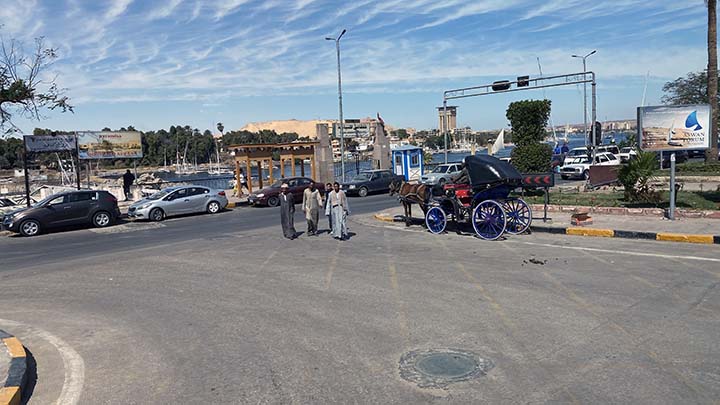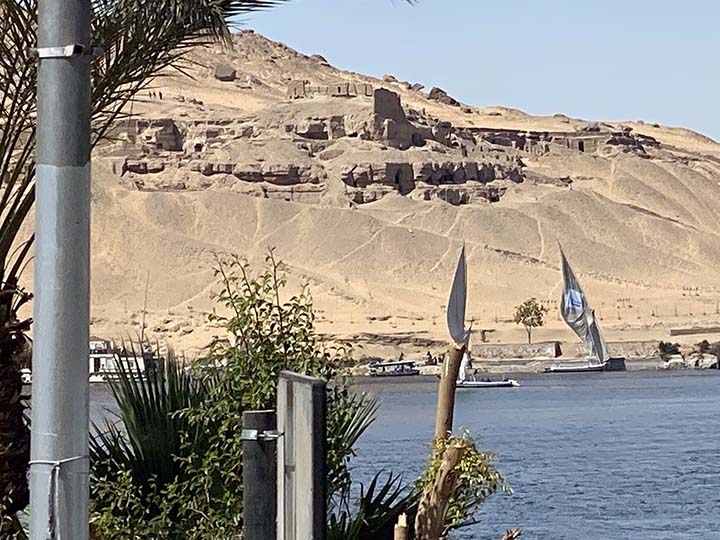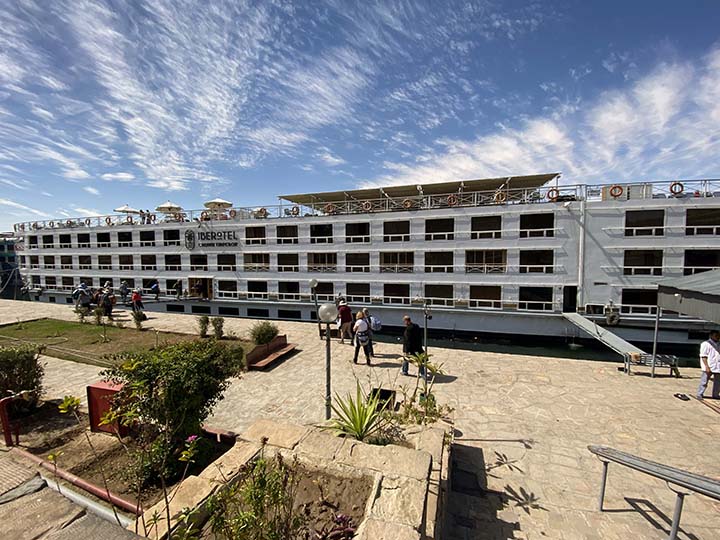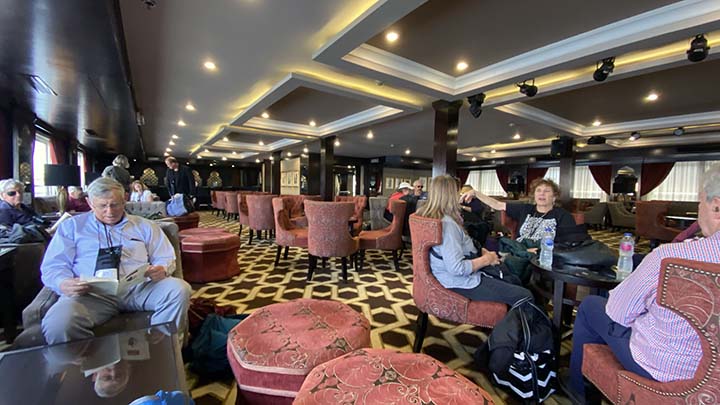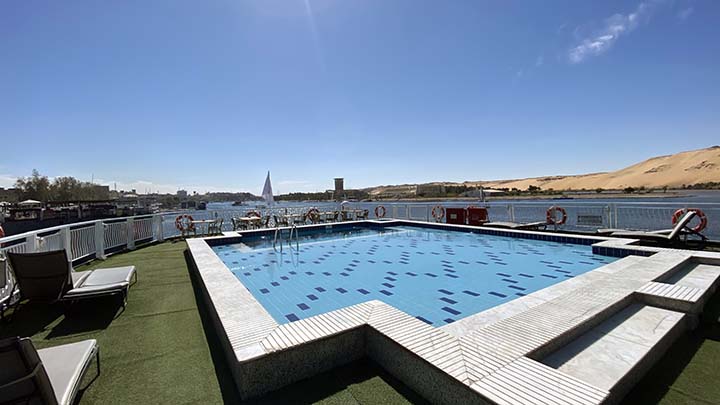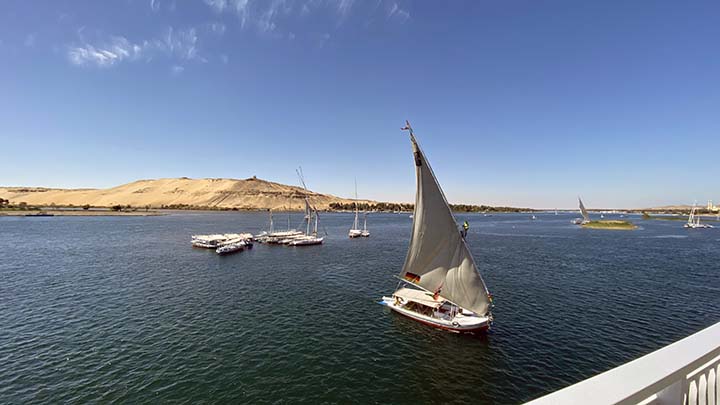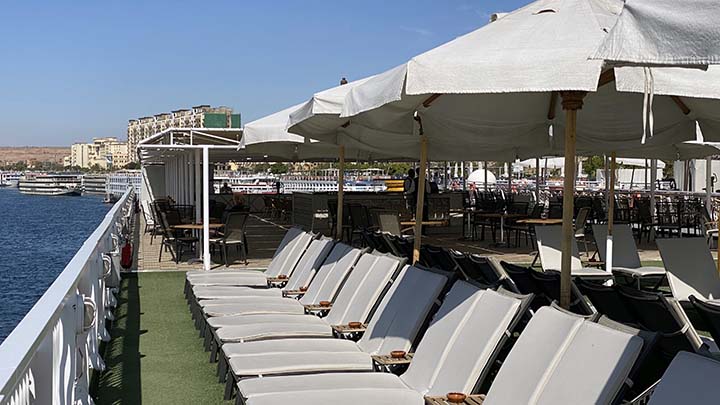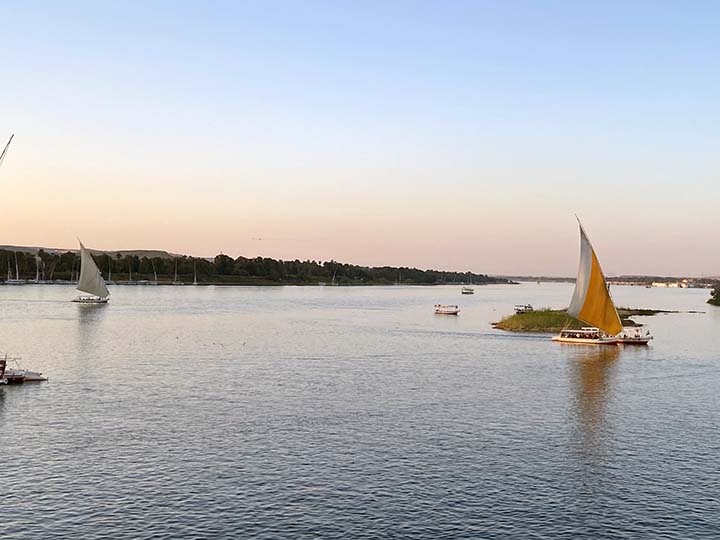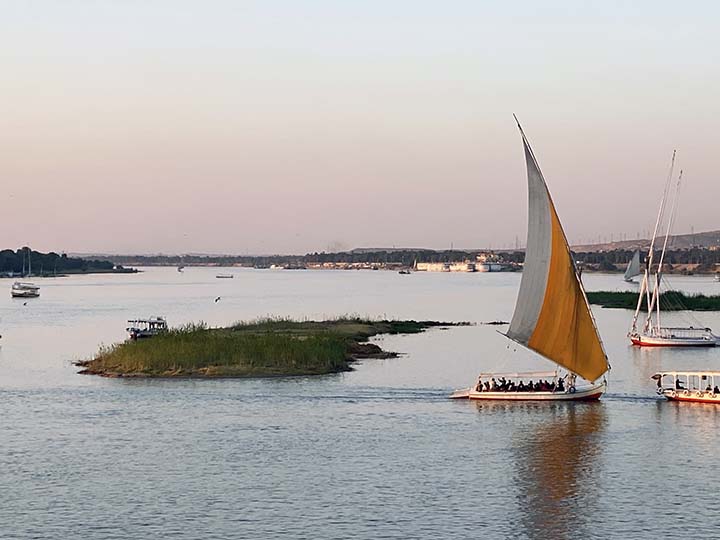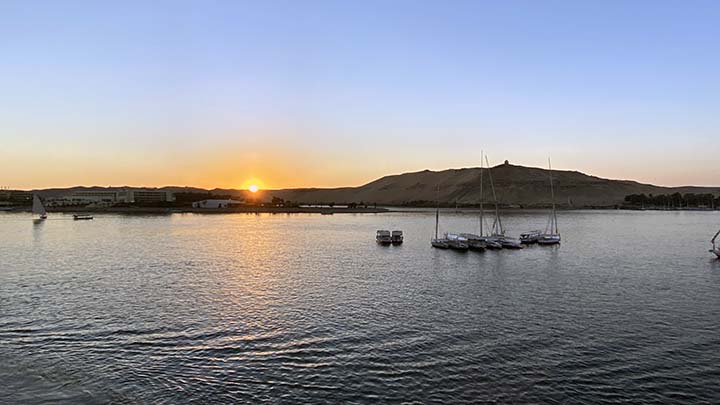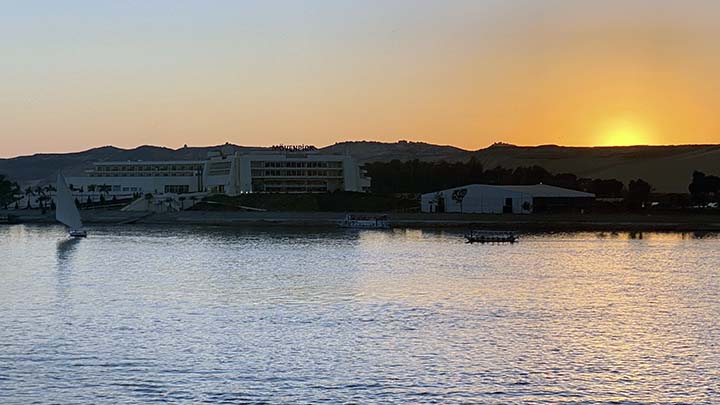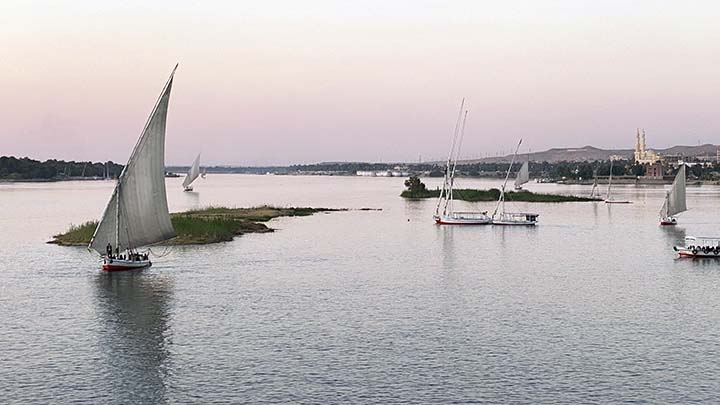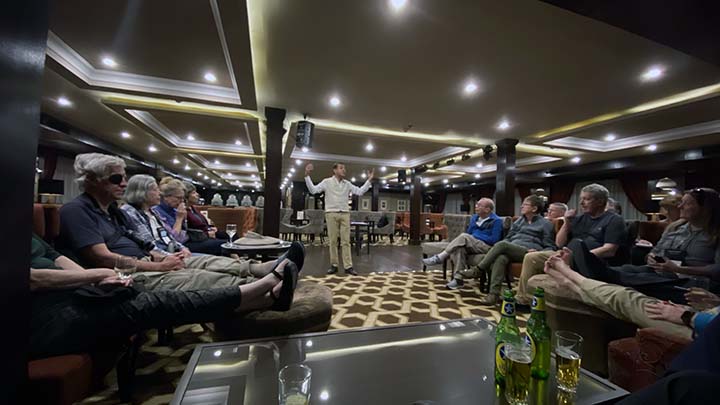|
We arose early this morning (wake up call two a.m.) and flew to Aswan to board a very nice (very very nice) river cruise boat where we will spend the next three nights as we travel downstream (north) on the Nile river to Luxor, and from there we will fly back to Cairo.
Itís hard to get a good aerial picture of the Sahara desert when youíre shooting with an iPhone from an aisle seat through an open window two rows in front of you. But thatís what that is: the Sahara desert.
We flew from Cairo to Aswan early this morning. Very early. Much too early.
See? It's an airport.
Our first stop on the bus was the Aswan High Dam. The Aswan Dam, or more specifically since the 1960s, the Aswan High Dam, is an embankment dam built across the Nile in Aswan, Egypt, between 1960 and 1970. Its significance largely eclipsed the previous Aswan Low Dam initially completed in 1902 downstream.
Based on the success of the Low Dam, then at its maximum utilization, construction of the High Dam became a key objective of the government following the Egyptian Revolution of 1952; with its ability to better control flooding, provide increased water storage for irrigation and generate hydroelectricity the dam was seen as pivotal to Egypt's planned industrialization. Like the earlier implementation, the High Dam has had a significant effect on the economy and culture of Egypt.
Above the dam it created Lake Nasser, one of the largest man-made lakes in the world. Before construction, Sudan was against the building of Lake Nasser because it would encroach on land in the North, where the Nubian people lived. They would have to be resettled. In the end Sudan's land near the area of Lake Nasser was mostly flooded by the lake. Strictly, "Lake Nasser" refers only to the much larger portion of the lake that is in Egyptian territory (83% of the total), with the Sudanese preferring to call their smaller body of water Lake Nubia
The lake is some 298 mi long and 9.9 mi across at its widest point, which is near the Tropic of Cancer. It covers a total surface area of 2,030 sq mi and has a storage capacity of some 32 cu mi of water.
In addition to producing hydroelectric power, it controls flooding along the Nile below. Itís not called the ďhighĒ dam because it is tall, which it is not. This is no spectacular-looking Hoover dam. Itís called the high dam because it sits higher on the Nile then a lower, much older dam. I keep having to remind myself that itís the south of Egypt that has the high country, and the Nile flows north to the Mediterranean Sea.
The High Dam has proven to be a mixed blessing for Egypt. It has resulted in protection from floods and droughts, an increase in agricultural production and employment, electricity production, and improved navigation that also benefits tourism.
Conversely, the dam flooded a large area, causing the relocation of over 100,000 people. Many archaeological sites were submerged while others were relocated. The dam is blamed for coastline erosion, soil salinity, and health problems.
Obviously the tourist has paused to weigh the pros and cons.
I didn't get a description of this place when I was there, but a little Googling at home has revealed it is the Beit El-Wali Temple. The Temple of Beit el-Wali is a rock-cut ancient Egyptian temple in Nubia which was built by Pharaoh Ramesses II and dedicated to the deities of Amun-Re, Re-Horakhti, Khnum and Anuket. It was the first in a series of temples built by Ramesses II in this region; its name Beit el-Wali means 'House of the Holy Man' and may indicate its previous use by a Christian hermit at some point in time. The temple was relocated during the 1960s as a result of the Aswan High Dam project and moved towards higher ground. We didn't go there.
Time to stop viewing Lake Nasser and get back on the bus.
The Soviet Union helped pay for construction of the dam initially, but they didnít keep up their end of the bargain later. This is a monument to the initial cooperation.
That thing that looks like a playground installation is actually a guard house at the dam.
Looks like a fun amusement park.
Now we are going to take a boat to the island of Philae.
The boat dock also serves as a bazaar.
You can buy lots of stuff here. Shades of Bhutan. Is this why they called him Ramses the Great?
You want trinkets? We got trinkets.
Colorful trinkets.
Pretty blue bowls too. Itís like thereís an acre of trinkets spread out on blankets all over the ground.
Some of them are downright pretty. But I didn't need a blue bowl.
The Road Scholars board their boat.
Accompanied by a nice man in a suit with a gun poking out of his jacket.
Let's go on a cruise.
Rafik smiles at his excellencies while the nice man in the suit keeps an eye out for trouble. By the way, there was never any trouble on this trip, or any hint of trouble.
We are off on an adventure.
Nice view.
Laurel is loving this.
Ours isn't the only boat in these waters.
Philae is an island in the reservoir of the Aswan Low Dam, downstream of the Aswan Dam and Lake Nasser, Egypt. Philae was originally located near the expansive First Cataract of the Nile in Upper Egypt and was the site of an Egyptian temple complex. These rapids and the surrounding area have been variously flooded since the initial construction of the Aswan Low Dam in 1902.
The temple complex was dismantled and moved to nearby Agilkia Island as part of the UNESCO Nubia Campaign project, protecting this and other complexes before the 1970 completion of the Aswan High Dam. So we are touring the temple on its new home of Agilkia Island, not its original location on Philae Island.
This is the Temple of Isis that was built in the late Ptolemaic and early Roman periods.
It looks just like what Iíve always seen in picture books.
This dock has shopping opportunities too. See all the blankets spread out?
On the bank of the river, is the charmingly small Kiosk of Trajan, which during Egypt's age of Victorian explorers was a favorite subject of famous English artists. It dates from the Roman Imperial period and was left unfinished.
The back of the entrance has carvings too.
It's the charmingly small Kiosk of Trajan again.
Does it look like some of these carvings have been damaged on purpose?
Christians chipped away at the carvings because they considered them blasphemous.
But by the time the Christians got busy with their chisels, the Romans had built a barracks close to the temple, completely covering this section. So these carvings remained untouched.
The tourist kept having to touch things to help himself believe he was really here, was really seeing these carvings he'd encountered previously only in photos. OK, and museums. And traveling exhibitions. OK.
Rafik explains it all.
Some 19th century tourist should have had his hand slapped.
The temple has been used by Coptic (Egyptian) Christians, as evidenced by this cross carved into the wall long after this was temple to Isis.
It's all so monumental. And old. And real.
Iíve seen enough Hollywood movies to know these men will do the bidding of a mummy.
We are standing in the Holy of Holies room in the Temple of Isis. Isis is a very important figure in the ancient world. She is associated with funeral rites but as the enchantress who resurrected Osiris and gave birth to Horus she is also the giver of life, a healer and protector of kings. She was known as ĎMother of Godí as the pharaoh of Egypt will be depicted as her son.
Isis was worshipped as the ideal mother and wife as well as the patroness of nature and magic. She was the friend of slaves, sinners, artisans and the downtrodden, but she also listened to the prayers of the wealthy, maidens, aristocrats and rulers. Isis is the mother of Horus, the falcon-headed deity associated with king and kingship. Isis is also known as protector of the dead and goddess of children.
Isis was the first daughter of Geb, god of the Earth, and Nut, goddess of the Sky, and she was born on the fourth intercalary day. She married her brother, Osiris, and she conceived Horus with him. Isis was instrumental in the resurrection of Osiris when he was murdered by Set. Using her magical skills, she restored his body to life after having gathered the body parts that had been strewn about the earth by Seth.
The Graffito of Esmet-Akhom (or Philae 436) is the last known inscription written in Egyptian hieroglyphs, dated to 394 CE. It is inscribed in the temple Isis at Philae in southern Egypt. The inscription accompanies and refers to an image of the Nubian god Mandulis wearing his characteristic crown. In addition to the hieroglyphic text there is also a demotic inscription. The demotic one is dated to "the day of the Birth of Osiris, his (?) dedication-festival, year 110 [ Diocletian epoch ]", corresponding to 24 August 394. At the time, Roman Egypt had been largely Christianized, and Egypt was a separate diocese within the Praetorian prefecture of the East.
Let's have a closer look at the charmingly small Kiosk of Trajan. Trajan's Kiosk, also known as Pharaoh's Bed by the locals, is a hypaethral temple currently located on Agilkia Island in southern Egypt. The unfinished monument is attributed to Trajan, Roman emperor from 98 to 117 AD, due to his depiction as pharaoh seen on some of the interior reliefs. However, the majority of the structure dates to an earlier time, possibly to the reign of Augustus. The temple was originally built on the island of Philae, near the lower Aswan Dam, and served as main entrance to the Philae Island Temple Complex from the Nile river. It was relocated to Agilika Island in the 1960s by UNESCO to save it from the rising waters of the Nile that followed the construction of the Aswan High Dam.
This 15-x-20 meter kiosk is 15.85 meters high; its function was likely "to shelter the bark of Isis at the eastern banks" of Philae island.
Its four by five columns each carry "different, lavishly structured composite capitals that are topped by 2.10-metre-high piers" and were originally "intended to be sculpted into Bes piers, similar to the birthhouses of Philae, Armant, and Dendera though this decoration was never completed.
The structure is today roofless, but sockets within the structure's architraves suggest that its roof, which was made of timber, was indeed constructed in ancient times. Three 12.50-metre-long, presumably triangulated trusses, "which were inserted into a ledge at the back of stone architecture, carried the slightly vaulted roof." All the fourteen columns are connected by a screening wall, with entrances in the eastern and western facades. This building represents an example of the unusual combination of wood and stone in the same architectural structure for an Egyptian temple. The attribution to Emperor Trajan is based on a carving inside the kiosk structure, depicting the emperor burning incense before Osiris and Isis.
The tourist marvels at all this.
And then everybody heads back to the boat.
Bye bye charmingly small Kiosk of Trajan.
It was all a wonder to behold.
But the Road Scholars have other adventures ahead.
After we took the boat back to the mainland, we went to see the famous unfinished obelisk of Aswan.
This is the kind of Aswan granite quarry that produced the stones that gave us the pyramids.
But this particular quarry was supposed to produce a monumental obelisk. Its creation was ordered by Hatshepsut (1508Ė1458 BC). The unfinished obelisk is nearly one-third larger than any ancient Egyptian obelisk ever erected. If finished it would have measured around 137 feet and would have weighed nearly 1,200 tons, a weight equal to about 200 African elephants.
The obelisk's creators began to carve it directly out of bedrock, but cracks appeared in the granite and the project was abandoned. The bottom side of the obelisk is still attached to the bedrock.
Road Scholars never pass up an opportunity to admire a cracked obelisk.
Now we are headed to the bank of the Nile River.
Water. See?
Thatís a boat, but it is not our boat. To get to our boat we had to walk up the gangplank into this one, cross through its grand reception area, walk out the other side and into another almost identical boat, walk through its grand reception area, and cross onto a third boat which is ours. Hooray! The Minerva.
The tourist thought he would take a well-deserved nap before dinner. Yeah, right. Guess it doesn't pay to have a stateroom right next to where all the action is.
Our boat, the Minerva, is big and pretty spiffy.
It has a pool which nobody swam in because, you know, the weather isn't exactly warm.
But from the side of the pool there's a great view of the Nile.
And places to relax.
And oh boy, is this nice or what?
It's like we're in a foreign country or something.
Where they have spectacular sunsets.
Bye sun. Looks like you are headed over to shine on the USA.
How many nights are we going to spend on this boat? Just three? I could get used to this. There is a downside, though. I have a very nice stateroom on the Minerva, third floor up near the bow where I can hear but not understand every word the crew utters
Rafik tells us all about it.
|

